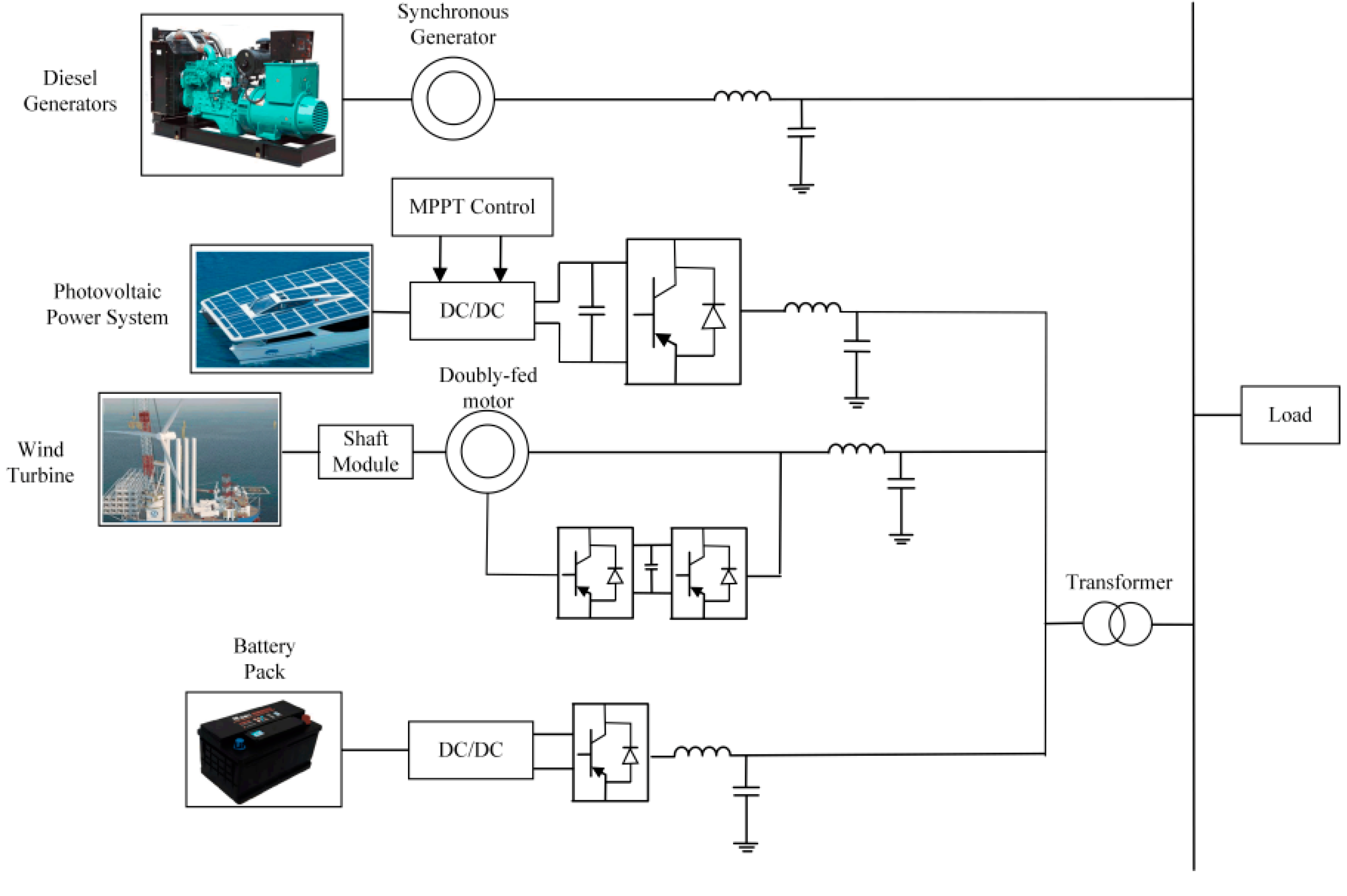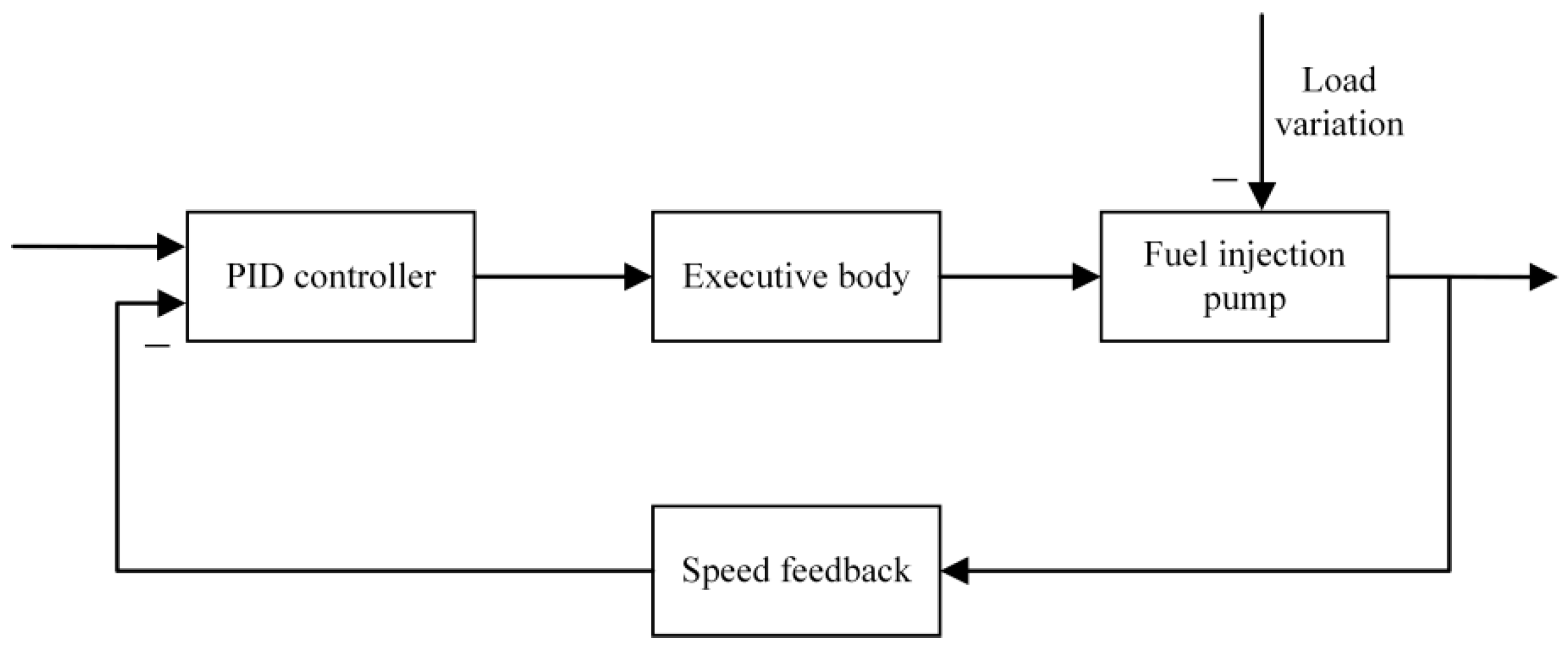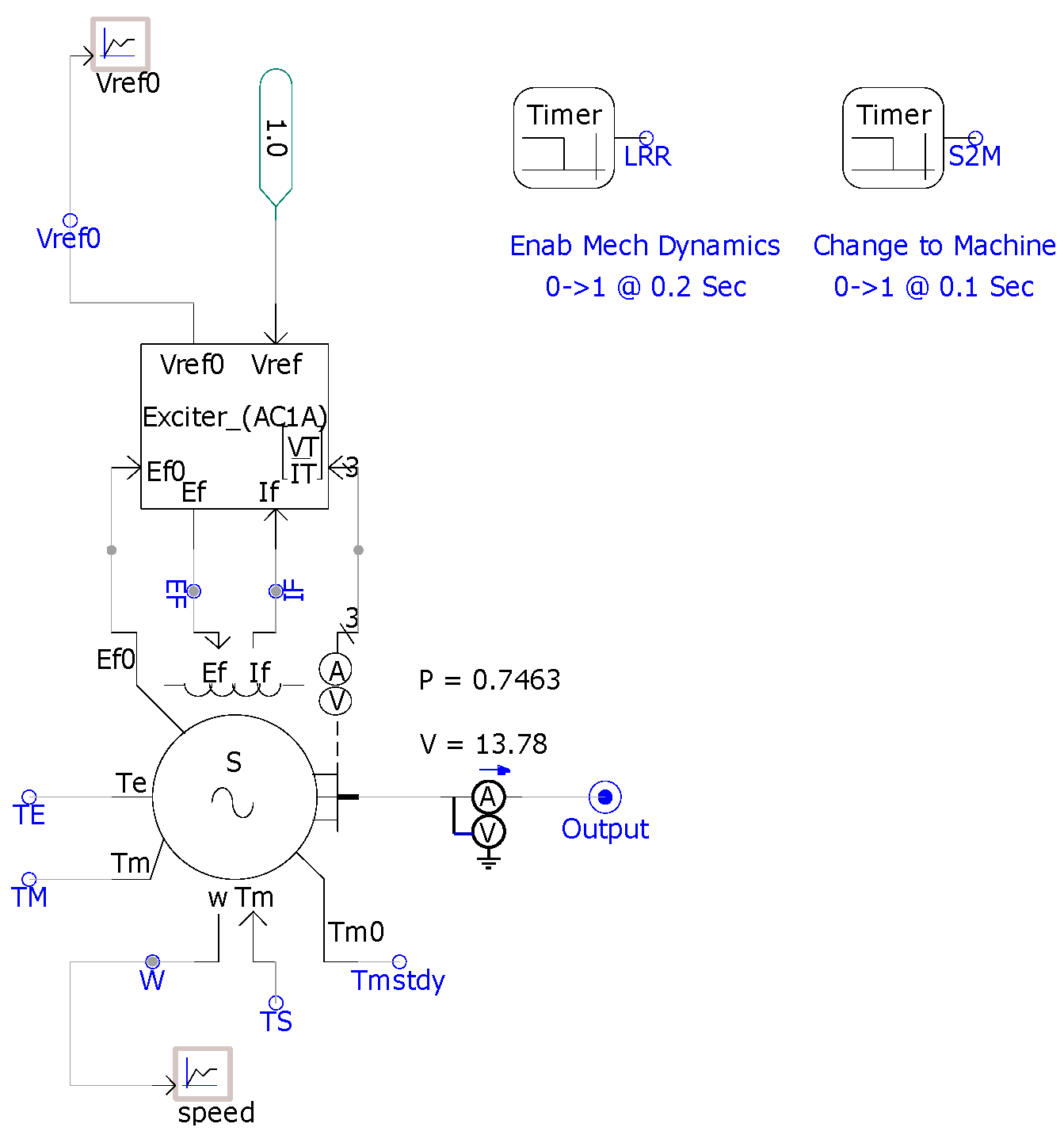Research on Multi-Energy Integrated Ship Energy Management System Based on Hierarchical Control Collaborative Optimization Strategy
Abstract
:1. Introduction
2. Typical System Structure and Mathematical Modeling of Hybrid Electric Ship
2.1. Typical System Structure
2.2. Distributed Power Mathematical Model
2.2.1. Diesel Engine and Speed-Governing System Model
2.2.2. Synchronous Generator and Excitation System Model
2.2.3. Photovoltaic Power Generation System Model
2.2.4. Doubly-Fed Wind Power Generation System Model
2.3. Mathematical Model of Energy Storage System
3. Hierarchical Control Scheme and Optimization Algorithm Design for Hybrid Ships
3.1. Hierarchical Control Scheme
3.2. Maximum Power Point Tracking Control Strategy for Ship Propulsion Systems
3.3. Design of Two-Layer Coordinated Control Strategy Based on Dynamic Droop Controller
3.4. Research on Day-Ahead Optimal Dispatching Strategy of Ship Power System
3.4.1. Mathematical Model of Day-Ahead Optimal Scheduling Problem in Power System
3.4.2. Research on Day-Ahead Optimization Scheduling Method Based on Improved PSO
4. Simulation Verification and Analysis
4.1. Simulation and Verification of MPPT Control Strategy Based on Improved Disturbance Observation Method
- Simulation of photovoltaic power generation system:
- 2.
- Wind Power System Simulation
4.2. Simulation Verification of Control Strategy Based on the Dynamic Droop Controller
4.3. Simulation Verification of Day-Ahead Optimal Scheduling Control Strategy
5. Conclusion and Discussion
- The overall scheme of the layered control system of the ship propulsion system is designed, and a detailed and complete mathematical model is established. An overall simulation model of the ship propulsion system is built, which meets the needs of subsequent related research and simulation tests.
- A P&O algorithm based on dynamic perturbation step size is designed, including oscillation detection mechanism, dynamic perturbation step adjustment strategy, and voltage boundary setting. Through the comparison example simulation test with the traditional algorithm, the results show that the power loss of the MPPT control strategy using the P&O algorithm with a dynamic disturbance step size is reduced by 39.3%, and the overall tracking time is prolonged by 15.4%.
- A three-layer coordinated control strategy of the propulsion system based on the dynamic droop coefficient is designed, which dynamically adjusts the fixed droop coefficient. Realizing the adaptive change of the droop coefficient solves the problem of voltage and frequency deviation. In order to improve the system performance, the power sensitivity factor is designed simultaneously; moreover, a voltage and current double closed-loop controller are further designed to improve the inverter noise immunity and power quality. The simulation results show that the proposed control strategy can effectively suppress the voltage and frequency fluctuations and improve the system-connected security and power quality of the system-connected side.
- A PSO algorithm based on mutation particles is designed, and the collection information of some top-ranked vectors is mixed in the generated mutation vector; furthermore, the method of the segmental improvement speed formula is adopted in order to improve the accuracy and search speed. Through the standard function performance test with other intelligent optimization algorithms, the results show that the improved algorithm has a faster convergence speed and higher accuracy in solving the load optimization problem. The total running cost of the algorithm is reduced 8.4%, and the total cost was reduced by 8.2%.
Author Contributions
Funding
Institutional Review Board Statement
Informed Consent Statement
Conflicts of Interest
Nomenclature
| Category | Symbol | Implication |
| abbreviations | PSO | Particle Swarm Optimization |
| IPSO | Improved Particle Swarm Optimization | |
| PV | Photovoltaic | |
| MPPT | Maximum Power Point Tracking | |
| P&O | Perturbation Observation Algorithm | |
| GA | Genetic Algorithm | |
| DE | Differential Evolution | |
| PWM | Pulse Width Modulation | |
| parameter | the damping coefficient | |
| the angular velocity of the diesel engine | ||
| the number of pole pairs of the synchronous generator | ||
| the output torque of the diesel engine | ||
| resistance torque of the diesel engine | ||
| the constant current source | ||
| the current passing through the diode | ||
| the temperature coefficient | ||
| the pitch angle of the blade | ||
| the maximum power output of the current | ||
| the maximum power output of the voltage | ||
| the voltage to the photovoltaic array | ||
| the open circuit voltage | ||
| the temperature of the photovoltaic array | ||
| the ambient temperature | ||
| the actual solar irradiance | ||
| the tip speed ratio | ||
| the rotational speed | ||
| the wind speed | ||
| the speed of wind turbines | ||
| the lithium battery voltage | ||
| the constant voltage source voltage | ||
| the lithium battery charge/discharge capacity | ||
| the filtered current | ||
| the state of charge of the lithium battery | ||
| the three-phase current output by the inverter | ||
| the three-phase voltage output by the inverter | ||
| the reference active power | ||
| the reference reactive power | ||
| the SPWM modulation signal | ||
| the given reference frequency | ||
| the given reference voltage | ||
| the dynamic droop coefficient | ||
| the dynamic droop factor | ||
| the sensitivity factor | ||
| the operating cost coefficients | ||
| the numbers of wind power generation units | ||
| the output power of wind power generation systems | ||
| the maximum number of iterations | ||
| the test vector function | ||
| the target vector function | ||
| an indicator used to monitor |
Appendix A
| SO2 | CO2 | CO | NOX |
|---|---|---|---|
| 4.34 | 2.32 | 0.47 | 232.04 |
Appendix B
| SO2 | CO2 | CO | NOX |
|---|---|---|---|
| 0.75 | 0.0028 | 0.125 | 1.00 |
References
- Pan, P.; Sun, Y.; Yuan, C.; Yan, X.; Tang, X. Research progress on ship power systems integrated with new energy sources: A review. Renew. Sust. Energ. Rev. 2021, 144, 111048. [Google Scholar] [CrossRef]
- Zhang, R.; Liang, H. Application of solar energy in ship power field. In Proceedings of the 2022 IEEE Asia-Pacific Conference on IPEC, Dalian, China, 14–16 April 2022. [Google Scholar]
- Zhu, Y.; Zhou, S.; Feng, Y.; Hu, Z.; Yuan, L. Influences of solar energy on the energy efficiency design index for new building ships. Int. J. Hydrogen Energy 2017, 42, 19389–19394. [Google Scholar] [CrossRef]
- Babarit, A.; Ghani, N.; Brouillette, E. Experiment validation of the energy ship concept for far-offshore wind energy conversion. Ocean Eng. 2021, 239, 109830. [Google Scholar] [CrossRef]
- Altosole, M.; Balsamo, F.; Campora, U.; Mocerino, L. Marine Dual-Fuel Engines Power Smart Management by Hybrid Turbocharging Systems. J. Mar. Sci. Eng. 2021, 9, 663. [Google Scholar] [CrossRef]
- Yuan, Y.; Wang, J.; Yan, X.; Shen, B.; Long, T. A review of multi-energy hybrid power system for ships. Renew. Sust. Energ. Rev. 2020, 132, 110081. [Google Scholar] [CrossRef]
- Huang, Y.; Wang, L.; Zhang, Y.; Wang, L.; Zhang, Z. An Overview of Multi-Energy Microsystem in All-Electric Ships. Front. Energy Res. 2022, 10, 881548. [Google Scholar] [CrossRef]
- Fang, S.; Xu, Y.; Li, Z. Two-Step Multi-Objective Management of Hybrid Energy Storage System in All-Electric Ship Microgrds. IEEE Trans. Veh. Technol. 2019, 68, 3361–3373. [Google Scholar] [CrossRef]
- Anvari, M.; Dragicevic, T.; Lexuan, M. Optimal planning and operation management of a ship electrical power system with energy storage system. In Proceedings of the IECON2016-42nd Annual Conference of the IEEE industrial Electronics Society, Florence, Italy, 23–26 October 2016. [Google Scholar]
- Misyris, G.; Marinopoulos, A.; Doukas, D. On battery state estimation algorithms for electric ship applications. Electr. Power Syst. Res 2017, 151, 115–124. [Google Scholar] [CrossRef]
- Lee, K.; Shin, D.; Yoo, D. Hybrid photovoltaic/diesel green ship operating in standalone and system-connected mode Experimental investigation. Energy 2013, 49, 475–483. [Google Scholar] [CrossRef]
- Accetta, A.; Pucci, M. Energy Management System in DC micro-system of Smart Ships: Main Gen-Set Fuel Consumption Minimization and Fault Compensation. IEEE Trans. Ind. Appl. 2019, 55, 3097–3113. [Google Scholar] [CrossRef]
- Brizuela-Mendoza, J.A.; Sorcia-Vazquez, F.D.J.; Rumbo-Morales, J.Y.; Lozoya-Ponce, R.E.; Rodriguez-Cerda, J.C. Active fault tolerant control based on eigen structure assignment applied to a 3-DOF helicopter. Asian J. Control 2021, 23, 673–684. [Google Scholar] [CrossRef]
- Zhu, L.; Han, J.; Peng, D. Fuzzy Logic based Energy Management Strategy for a Fuel Cell/Battery/Ultra-capacitor Hybrid Ship. In Proceedings of the International Conference on Green Energy, Sfax, Tunisia, 25–27 March 2014. [Google Scholar]
- Feng, X.; Butler-Purry, K.L.; Zourntos, T. A Multi-Agent System Framework for Real-Time Electric Load Management in MVAC All-Electric Ship Power Systems. IEEE Trans. Power Syst. 2015, 30, 1327–1336. [Google Scholar] [CrossRef]
- Seenumani, G.; Peng, H.; Jing, S. A Reference Governor-Based Hierarchical Control for Failure Mode Power Management of Hybrid Power Systems for All-electric Ships. J. Power Sources 2011, 196, 1599–1607. [Google Scholar] [CrossRef]
- Nelson, M.; Jordan, P.E. Automatic Reconfiguration of a Ship’s Power System Using Graph Theory Principles. IEEE Trans. Ind. Appl. 2015, 51, 2651–2656. [Google Scholar] [CrossRef]
- Mensah, E.; Kwatny, H. Models for Optimal Dynamic Reconfiguration and Simulation of Ship Power Systems in Simlink with Stateflow. In Proceedings of the 2007 IEEE Electric Ship Technologies Symposium, Arlington, VA, USA, 21–23 May 2007. [Google Scholar]
- Hou, J.; Sun, J.; Hofmann, H. Interaction Analysis and Integrated Control of Hybrid Energy Storage and Generator Control System for Electric Ship Propulsion. In Proceedings of the American Control Conference (ACC), Chicago, IL, USA, 1–3 July 2015. [Google Scholar]
- Kanellos, F.D.; Tsekouras, G.J.; Hatziargyriou, N.D. Optimal Demand-Side Management and Power Generation Scheduling in an All-Electric Ship. IEEE Trans. Sustain. Energy 2014, 5, 1166–1175. [Google Scholar] [CrossRef]
- López, A.R.; Mina, J.D.; Calderón, G.; Aguayo, J.; Calleja, J.H. Combined parameters selection of a proportional integral plus resonant controller for harmonics compensation in a wind energy conversion system. Electr. Eng. 2018, 100, 2277–2286. [Google Scholar] [CrossRef]
- Paran, S.; Vu, T.V.; Mezyani, T. MPC-based Power Management in the Shipboard Power System. In Proceedings of the 2015 IEEE Electric Ship Technologies Symposium (ESTS), Alexandria, VI, USA, 21–24 July 2015. [Google Scholar]
- Hatata, A.Y.; Osman, G.; Aladl, M.M. An optimization method for sizing a solar/wind/battery hybrid power system based on the artificial immune system. Sustain. Energy Technol. 2018, 27, 83–93. [Google Scholar] [CrossRef]
- Hadidian, M.J.; Nowdeh, S.A. Optimal sizing and energy management of stand-alone hybrid photovoltaic/wind system based on hydrogen storage considering LOEE and LOLE reliability indices using flower pollination algorithm. Renew Energy 2019, 135, 1412–1434. [Google Scholar] [CrossRef]
- Sanajaoba, S.S.; Fernandez, E. Modeling, size optimization and sensitivity analysis of a remote hybrid renewable energy system. Energy 2018, 143, 719–731. [Google Scholar] [CrossRef]
- De la Cruz, J.; Ramirez, J.M.; Leyva, L. Modification of Geometric Parameters in Outer Rotor Permanent Magnet Generators to Improve THD, Efficiency, and Cogging Torque. Int. J. Emerg. Electr. Power Syst. 2014, 15, 471–483. [Google Scholar] [CrossRef]
- Zhang, W.; Maleki, A. A heuristic-based approach for optimizing a small independent solar and wind hybrid power scheme incorporating load forecasting. J. Clean. Prod. 2019, 241, 117920. [Google Scholar] [CrossRef]
- Maleki, A.; Pourfayaz, F. Optimal sizing of autonomous hybrid photovoltaic/wind/battery power system with LPSP technology by using evolutionary algorithms. Sol. Energy 2015, 115, 471–483. [Google Scholar] [CrossRef]
- Borunda, M.; Garduno, R.; Nicholson, A.E.; De la Cruz, J. Assessment of Small-Scale Wind Turbines to Meet High-Energy Demand in Mexico with Bayesian Decision Networks. In Proceedings of the 18th Mexican International Conference on Artificial Intelligence (MICAI), Xalapa, Mexico, 27 November–2 November 2019. [Google Scholar]
- Xu, L.; Wei, B.; Yun, Y. Coordinated Control of Diesel Generators and Batteries in DC Hybrid Electric Shipboard Power System. J. Mar. Sci. Eng. 2021, 14, 6246. [Google Scholar] [CrossRef]
- Lamichhane, A.; Zhou, L.; Yao, G. Modeling, Control and Power Management of Six-Phase PMSM Based Shipboard MVDC Distribution System. J. Mar. Sci. Eng. 2020, 13, 4229. [Google Scholar] [CrossRef]
- Nair, R.; Narayanan, G. Emulation of Wind Turbine System Using Vector Controlled Induction Motor Drive. IEEE Trans. Ind. Appl. 2020, 56, 4124–4133. [Google Scholar] [CrossRef] [Green Version]
- Puchalapalli, S.; Tiwari, S.; Singh, B.; Goel, P. A Microsystem Based on Wind-Driven DFIG, DG, and Solar PV Array for Optimal Fuel Consumption. IEEE Trans. Ind. Appl. 2020, 56, 4689–4699. [Google Scholar] [CrossRef]
- He, W.; Mo, O. Accelerating Efficient Installation and Optimization of Battery Energy Storage System Operations Onboard Vessels. J. Mar. Sci. Eng. 2022, 15, 4098. [Google Scholar] [CrossRef]
- Kim, S.; Kim, J. Optimal Energy Control of Battery Hybrid System for Marine Vessels by Applying Neural Network Based on Equivalent Consumption Minimization Strategy. J. Mar. Sci. Eng. 2021, 9, 1228. [Google Scholar] [CrossRef]
- Antonopoulos, S.; Vissser, K.; Kalikatzarakis, M.; Reppa, V. MPC Framework for the Energy Management of Hybrid Ships with an Energy Storage System. J. Mar. Sci. Eng. 2021, 9, 993. [Google Scholar] [CrossRef]
- Jin, Z.; Meng, L.; Guerrero, J.; Han, R. Hierarchical Control Design for Shipboard Power System with DC Distribution and Energy Storage Aboard Future More-Electric Ships. IEEE Trans. Industr. Inform. 2018, 14, 703–714. [Google Scholar] [CrossRef]
- Deng, C.; Wen, C.; Zou, Y.; Wang, W.; Li, X. A Hierarchical Security Control Framework of Nonlinear CPS Agent DoS Attacks With Application To Power Sharing of AC Microgrid. IEEE Trans. Cybern. 2022, 52, 5255–5266. [Google Scholar] [CrossRef] [PubMed]
- Xiao, S.; Dong, J. Distributed Fault-Tolerant Containment Control for Linear Heterogeneous Multiagent System: A Hierarchical Design Approach. IEEE Trans. Cybern. 2022, 52, 971–981. [Google Scholar] [CrossRef] [PubMed]
- Cortajarena, J.; Barambones, O.; Alkorta, P.; Cortajarena, J. Sliding mode control of an active power filter with photovoltaic maximum power tracking. Int. J. Electr. Power Energy Syst. 2019, 110, 747–758. [Google Scholar] [CrossRef]
- Mousa, H.; Youssef, A.; Mohamed, E. State of the art perturb and observe MPPT algorithms based wind energy conversion systems: A technology review. Int. J. Electr. Power Energy Syst. 2021, 126, 106598. [Google Scholar] [CrossRef]
- Farhat, M.; Barambones, O.; Sbita, L. A Real-Time Implementation of Novel and Stable Variable Step Size MTTP. Energies 2020, 13, 4668. [Google Scholar] [CrossRef]
- Abo Gabl, O.M.; Shaaban, M.F.; Zeineldin, H.H.; Ammar, M.E. A Multi-objective Secondary Control Approach for Optimal Design of DG Droop Characteristic and Control Mode for Autonomous Micrsystems. IEEE Syst. J. 2021, 8, 1–10. [Google Scholar] [CrossRef]
- Shivam; Dahiya, R. Distributed Control for DC Microsystem Based on Optimized Droop Parameters. IETE J. Res. 2020, 66, 192–203. [Google Scholar] [CrossRef]
- Mo, S.; Chen, W.-H.; Lu, X. Hierarchical Hybrid Control for Scaled Consensus and Its Application to Secondary Control for DC Microgri. IEEE Trans. Cybern. 2022, 1–13. [Google Scholar] [CrossRef]
- Hou, P.; Hu, W.; Soltani, M.; Chen, Z. Optimized Placement of Wind Turbines in Large-Scale Offshore Wind Farm Using Partical Swarm Optimization Algorithm. IEEE Trans. Sustain. Energy 2015, 6, 1272. [Google Scholar] [CrossRef]
- Yang, R.; Wei, H.; Wang, L. Research on Energy Regulation and Optimal Operation Strategy of Multi-energy Ship Power Station Based on Improved Particle Swarm Algorithm. In Proceedings of the 2021 IEEE 5th Conference on IAEAC, Chongqing, China, 12–14 March 2021. [Google Scholar]
- Jasim, A.; Jasim, B.; Kraiem, H.; Flah, A. A Multi-Objective Demand/Generation Scheduling Model-Based Microsystem Energy Management System. J. Mar. Sci. Eng. 2022, 14, 10158. [Google Scholar]




















| Symbol | Symbol | Slope Value |
|---|---|---|
| + | + | +1 |
| + | − | −1 |
| − | + | −1 |
| − | − | +1 |
| Algorithm | Track Time (s) | Maximum Power Loss (kW) |
|---|---|---|
| traditional P&O | 341.1 | 15.46 |
| improved P&O | 393.7 | 4.74 |
| Day-Ahead Planned Cost | Improvement Strategy | Fixed Strategy * |
|---|---|---|
| Diesel generator fuel cost | 7663.2 | 8371.2 |
| Environmental cost of diesel generator | 751.51 | 820.93 |
| Operating cost of diesel generator | 28.74 | 28.74 |
| Cost of energy storage system | 280 | 400 |
| Renewable energy cost | 99.19 | 99.19 |
| Load profit | 1215 | 1215 |
| Total cost | 10,037.64 | 10,935.06 |
Publisher’s Note: MDPI stays neutral with regard to jurisdictional claims in published maps and institutional affiliations. |
© 2022 by the authors. Licensee MDPI, Basel, Switzerland. This article is an open access article distributed under the terms and conditions of the Creative Commons Attribution (CC BY) license (https://creativecommons.org/licenses/by/4.0/).
Share and Cite
Ren, Y.; Zhang, L.; Shi, P.; Zhang, Z. Research on Multi-Energy Integrated Ship Energy Management System Based on Hierarchical Control Collaborative Optimization Strategy. J. Mar. Sci. Eng. 2022, 10, 1556. https://doi.org/10.3390/jmse10101556
Ren Y, Zhang L, Shi P, Zhang Z. Research on Multi-Energy Integrated Ship Energy Management System Based on Hierarchical Control Collaborative Optimization Strategy. Journal of Marine Science and Engineering. 2022; 10(10):1556. https://doi.org/10.3390/jmse10101556
Chicago/Turabian StyleRen, Yuanjie, Lanyong Zhang, Peng Shi, and Ziqi Zhang. 2022. "Research on Multi-Energy Integrated Ship Energy Management System Based on Hierarchical Control Collaborative Optimization Strategy" Journal of Marine Science and Engineering 10, no. 10: 1556. https://doi.org/10.3390/jmse10101556
APA StyleRen, Y., Zhang, L., Shi, P., & Zhang, Z. (2022). Research on Multi-Energy Integrated Ship Energy Management System Based on Hierarchical Control Collaborative Optimization Strategy. Journal of Marine Science and Engineering, 10(10), 1556. https://doi.org/10.3390/jmse10101556








